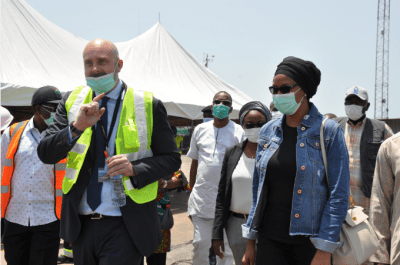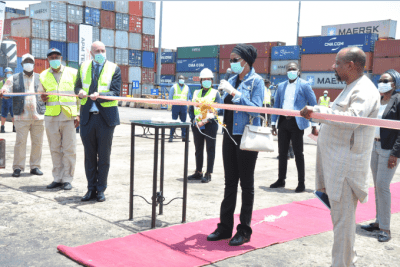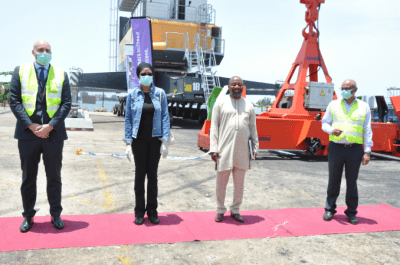
The Managing Director of Nigerian Ports Authority (NPA), Hadiza Bala Usman, on Thursday commissioned two new multimillion dollars state-of-the-art Mobile Harbor Cranes (MHCs) acquired by leading global terminal operator, APM Terminals, to boost service delivery at the Apapa Port, Lagos.
The new cranes were acquired as part of APM Terminals’ additional investment of USD80 million (N33.6billion) for the year 2020-2021, bringing the total investment by the company in Apapa since 2006 to USD438million (about N184billion), which is the highest by any private terminal operator in Nigeria.
APM Terminals, which is located in the nation’s premiere seaport at the heart of Nigeria’s commercial hub, Lagos, is the biggest container terminal in West Africa and the best-equipped port terminal in Nigeria.
While commending the management of APM Terminals for acquiring the new cranes, Bala Usman said the ports were concessioned by the Federal Government to improve port efficiency and free government resources for other developmental purposes.
She said cargo volumes at the port have witnessed a steady rise due to favourable government policies.

Bala Usman said NPA has continued to engage with private terminal operators at the port to rise up to the challenge of the increased cargo traffic.
The engagement with the operators, according to her, is yielding tangible results as evidenced by the commissioning of the two new Mobile Harbor Cranes, among others.
She said as the ports become more efficient, efforts must be made to enhance cargo delivery processes and free the ports of longstanding cargo.
“We are engaging with the Nigeria Customs Service to remove overtime containers from the port to free vital space for incoming cargo.
“We are also working with terminal operators to increase the barging of containers to take pressure off the roads. We have noted a significant growth in barging capacity and operations with more containers moved daily by barges from the port,” she said.
Speaking earlier, the Head of Terminals, Africa and Middle East region of APM Terminals, Mr. David Skov, said before now, the company had invested USD358million (N150.36billion) in port infrastructure development, information technology upgrades and modern cargo handling equipment to improve both quayside and landside operations.
He said, “The additional investment we are making is to handle the increased trade volumes into Nigeria. Trade in Nigeria is growing due to the many favorable efforts and policies of the Federal government of Nigeria including but not limited to the policy on ease of doing business; stabilization of foreign exchange; closure of the land borders which has increased the use of our sea ports; and diversification of the economy.
“The additional investments will create capacity to handle the growth in the economy to support the Federal government’s efforts on trade growth and improve service delivery across the logistic chain in Nigeria.”
He said with the acquisition of the new cranes, the terminal now operates with a total of 10 Mobile Harbour Cranes; 23 Rubber-Tyred Gantry Cranes; six Empty Handlers; 48 specialised Truck Terminals, six Reach Stackers and 11 Forklifts.

Also speaking, the President-General, Maritime Workers Union of Nigeria (MWUN), Comrade Adewale Adeyanju, who was represented by the union’s Deputy President-General, Comrade Tonye Harry, commended APM Terminals for the investment and for improving port services in Nigeria.
Other dignitaries at the crane commissioning ceremony include the Managing Director, APM Terminals Apapa, Mr. Martin Jacob; Executive Director, Marine and Operations of NPA, Mr. Onari Brown; the General Manager Marine and Operations, Captain Jerome Anyugwe; the General Manager Monitoring and Regultory Service, Mrs. Ugo Madubuike and NPA General Manager, Security, Mr. Olumide Omotosho. Others are the Port Manager, Lagos Port Complex Apapa, Mrs Olufunmilayo Olotu; and the Port Manager, Tin Can Island Port, Mr. Umar Abubakar Garba.
APM Terminals Apapa took over operation of the Apapa container terminal in 2006 under the Federal Government’s port reform programme.
Before now, the company had invested heavily on infrastructure, container handling equipment, yard expansion, modernisation of the terminals’ IT hardware and software systems, and development of additional capacity.
The huge investment has resulted in significant improvements in productivity, reduction in vessel waiting time and a doubling of container volumes at the port.